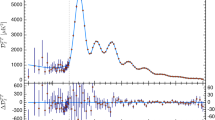Abstract
It is shown that cosmic radiation almost follows a Planck distribution, because just as matter is formed, its density of energy is negligible in comparison with that of radiation, and that the present age of the Universe does not depend on the particular manner in which the matter is formed.
Thus, if the results of the latest observations (which imply a deceleration parameterq=1.6) are combined with the assumption that the present age of the Universe is at least 12×109 yr, they lead to a hyperbolic oscillating universe with a negative cosmological constant (λ<−1.53×10−56 cm−2) and a present mass-density ρ m of less than 1.2×10−30 g cm−3. If the cosmological constant is taken to be zero, a solution is only possible if we are prepared to admit a rate of evolution of galaxies with a deceleration parameterq<0.52. Three types of oscillating universe are then possible, but the heperbolic type is the most probable. If Hubble's constant is greater than 63.4 km s−1 Mpc−1, the solutions are only hyperbolic universes with λ<+0.45×10−56 cm−2 and ρ m <4.8×10-30g cm-3.
Sommaire
On montre que le rayonnement cosmique général suit pratiquement une loi de Planck parce que la densité d'énergie de la matière au moment de sa formation est négligeable à côté de celle du rayonnement et que l'âge actuel de l'Univers ne dépend pas du mode de formation de la matière.
Dans ces conditions, si l'on combine les derniers résultats d'observations (qui impliquent un paramètre de décélérationq=1.6) avec l'hypothèse que l'âge actuel de l'Univers est au moins de 12×109 années on est conduit à un Univers hyperbolique oscillant à constante cosmologique négative (λ<−1.53×10−56 cm−2) et où l'actuelle densité de matière ρ m est moindre que 1.2×10−30 g cm−3. Si la constante cosmologique est supposée nulle, une solution ne peut être obtenue que si l'on admet un certain taux d'évolution des Galaxies et un paramètre de décélérationq<0.52. Alors, les trois types d'Univers oscillants sont possibles, mains les Univers hyperboliques paraissent plus probables. Enfin, si la constante de Hubble est plus grande que 63.4 km s−1 Mpc−1 les solutions ne peuvent être que des Univers hyperboliques avec λ<+0.45×10−56 cm−2 et ρ m <4.8×10-30g cm-3.
Similar content being viewed by others
References
Holmberg, E.: 1958,Medd. Lunds Obs., II, No. 136.
Kristian, J., Sandage, A. and Westphal, J. A.: 1978,Astrophys. J. 221, 383.
Lang, K. R.: 1974,Astrophysical Formulae, Springer Verlag, New York.
Tolman, R. C.: 1934,Relativity, Thermodynamics and Cosmology. Oxford University Press.
Author information
Authors and Affiliations
Rights and permissions
About this article
Cite this article
Bouigue, R. Models of the universe compatible with present observations. Astrophys Space Sci 72, 87–96 (1980). https://doi.org/10.1007/BF00642167
Received:
Issue Date:
DOI: https://doi.org/10.1007/BF00642167




